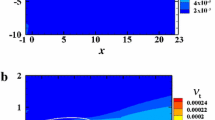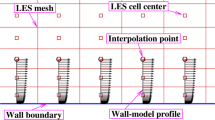Abstract
The large-eddy simulation (LES) with the dynamic Smagorinsky model is used to predict the interior sound of an idealized vehicle cabin under the excitation of the wall pressures from turbulent channel flows. In comparison with direct numerical simulation (DNS), the LES results overpredict the sound pressure level (SPL) at low frequencies and underpredict the SPL at high frequencies. The incorrect predictions result from the incorrect prediction of LES on surface pressures, where the LES over-estimates the wavenumber and frequencies spectra of surface pressures at small wavenumbers and frequencies and under-estimates the spectra at large wavenumbers and frequencies. However, the LES results are close to the filtered-DNS results, implying that the unresolved scales are also important to surface pressures and interior sound. The Euler-Bernoulli beam under the excitation of exterior pressures, which serves as a simple model for aero-vibro-acoustics in the case of hydrodynamical fast, is used to explain the observed predictions and show that the Corcos model cannot represent the variation of turbulence pressure spectra at wavenumbers and frequencies. Therefore, the new requirement for the LES method, when applied to fluid-structural-acoustic interaction problems at high Reynolds numbers, is the correct prediction of wavenumber and frequency spectra of turbulence wall pressure.
摘要
高雷诺数流固声耦合的大涡模拟是湍流和计算流体力学的前沿领域. 它可以用于飞机、潜艇和新能源汽车的舱内噪声预测. 本文设计了槽道湍流激励下的平板- 空腔系统作为典型案例, 研究了大涡模拟方法用于高雷诺数流固声耦合系统的可能性. 我们的数 值结果表明, 基于动态Smagorinsky 模型的大涡模拟方法得到的振动声学响应与直接数值模拟接近, 但是在高频部分低估了振动声学 响应, 并在低频部分高估响应. 其主要原因在于大涡模拟未能准确预测壁面压力时空能谱, 而时空能谱决定了流固声耦合系统的振动 声学响应. 通过Corcos 模型激励的Euler-Bernoulli 梁的理论分析, 我们确认了不准确壁面压力时空能谱影响振动声学响应的机制. 最 后, 本文工作表明了有必要通过发展新型的亚格子项模型, 提升壁面压力时空能谱的预测精度, 最终实现大涡模拟方法对高雷诺数流 固声耦合系统的准确预测.

Similar content being viewed by others
References
W. K. Blake, Mechanics of Flow-Induced Sound and Vibration, Volume 1 (Academic Press, Cambridge, 2017).
C. Hansen, Foundations of Vibroacoustics (CRC Press, Boca Raton, 2018).
S. Glegg, and W. Devenport, Aeroacoustics of Low Mach Number Flows: Fundamentals, Analysis, and Measurement (Academic Press, Cambridge, 2017).
Z. Zhou, H. Wang, and S. Wang, Simplified permeable surface correction for frequency-domain Ffowcs Williams and Hawkings integrals, Theor. Appl. Mech. Lett. 11, 100259 (2021).
Hubbard, H.H.: Aeroacoustics of Flight Vehicles: Theory and Practice. Volume 2: Noise Control, Tech. Rep. NASA-RP-1258-VOL-2, NASA, 1991.
J. F. Wilby, Aircraft interior noise, J. Sound Vib. 190, 545 (1996).
J. Sobieszczanski-Sobieski, S. Kodiyalam, and R. Y. Yang, Optimization of car body under constraints of noise, vibration, and harshness (NVH), and crash, Struct. Multidisciplinary Optim. 22, 295 (2001).
C. Q. Howard, in Recent developments in submarine vibration isolation and noise control: Proceedings of the 1st Submarine Science Technology and Engineering Conference, Adelaide, 2011.
W. R. Graham, Boundary layer induced noise in aircraft, part I: The flat plate model, J. Sound Vib. 192, 101 (1996).
C. Maury, P. Gardonio, and S. J. Elliott, A wavenumber approach to modelling the response of a randomly excited panel, part I: General theory, J. Sound Vib. 252, 83 (2002).
C. Maury, P. Gardonio, and S. J. Elliott, A wavenumber approach to modelling the response of a randomly excited panel, part II: Application to aircraft panels excited by a turbulent boundary layer, J. Sound Vib. 252, 115 (2002).
D. M. Mead, Wave propagation in continuous periodic structures: Research contributions from southampton, 1964–1995, J. Sound Vib. 190, 495 (1996).
J. H. Lee, and J. Kim, Analysis of sound transmission through periodically stiffened panels by space-harmonic expansion method, J. Sound Vib. 251, 349 (2002).
L. Maxit, M. Karimi, V. Meyer, and N. Kessissoglou, Vibroacoustic responses of a heavy fluid loaded cylindrical shell excited by a turbulent boundary layer, J. Fluids Struct. 92, 102758 (2020).
L. Maxit, O. Guasch, V. Meyer, and M. Karimi, Noise radiated from a periodically stiffened cylindrical shell excited by a turbulent boundary layer, J. Sound Vib. 466, 115016 (2020).
A. Culla, W. D’Ambrogio, A. Fregolent, and S. Milana, Vibroacoustic optimization using a statistical energy analysis model, J. Sound Vib. 375, 102 (2016).
T. Lafont, N. Totaro, and A. Le Bot, Review of statistical energy analysis hypotheses in vibroacoustics, Proc. R. Soc. A. 470, 20130515 (2014).
T. J. Hughes, The Finite Element Method: Linear Static and Dynamic Finite Element Analysis (Courier Corporation, North Chelmsford, 2012).
T. Wu, Boundary Element Acoustics: Fundamentals and Computer Codes, No. 7 in Advances in Boundary Elements (WIT Press, Ashurst, 2000).
S. Suleau, A. Deraemaeker, and P. Bouillard, Dispersion and pollution of meshless solutions for the Helmholtz equation, Comput. Methods Appl. Mech. Eng. 190, 639 (2000).
Z. C. He, E. Li, G. R. Liu, G. Y. Li, and A. G. Cheng, A mass-redistributed finite element method (MR-FEM) for acoustic problems using triangular mesh, J. Comput. Phys. 323, 149 (2016).
P. Chen, I. P. A. Wijaya, I. Tuttle, and A. Masud, Interfacial coupling across incompatible meshes in a monolithic finite-strain thermomechanical formulation, Computers Mathematics with Applications 79, 3068 (2020).
J. Abshagen, and V. Nejedl, Towed body measurements of flow noise from a turbulent boundary layer under sea conditions, J. Acoust. Soc. Am. 135, 637 (2014).
Y. F. Hwang, W. K. Bonness, and S. A. Hambric, Comparison of semi-empirical models for turbulent boundary layer wall pressure spectra, J. Sound Vib. 319, 199 (2009).
T. S. Miller, J. M. Gallman, and M. J. Moeller, Review of turbulent boundary layer models for acoustic analysis, J. Aircraft 49, 1739 (2012).
G. M. Corcos, The structure of the turbulent pressure field in boundary-layer flows, J. Fluid Mech. 18, 353 (1964).
W. A. Strawderman, and R. A. Christman, turbulence-induced plate vibrations: Some effects of fluid loading on finite and infinite plates, J. Acoust. Soc. Am. 52, 1537 (1972).
W. A. Strawderman, and R. S. Brand, turbulent-flow-excited vibration of a simply supported, rectangular flat plate, J. Acoust. Soc. Am. 45, 177 (1969).
B. Efimtsov, Characteristics of the field of turbulent wall pressure-fluctuations at large reynolds-numbers, Soviet Phys. Acoust.-USSR 28, 289 (1982).
D. M. Chase, The character of the turbulent wall pressure spectrum at subconvective wavenumbers and a suggested comprehensive model, J. Sound Vib. 112, 125 (1987).
A. V. Smol’Yakov, A new model for the cross spectrum and wavenumber-frequency spectrum of turbulent pressure fluctuations in a boundary layer, Acoust. Phys. 52, 331 (2006).
M. Slama, C. Leblond, and P. Sagaut, A Kriging-based elliptic extended anisotropic model for the turbulent boundary layer wall pressure spectrum, J. Fluid Mech. 840, 25 (2018).
B. Shi, X. Yang, G. Jin, G. He, and S. Wang, Wall-modeling for large-eddy simulation of flows around an axisymmetric body using the diffuse-interface immersed boundary method, Appl. Math. Mech.-Engl. Ed. 40, 305 (2019).
Z. Li, and X. Yang, Evaluation of actuator disk model relative to actuator surface model for predicting utility-scale wind turbine wakes, Energies 13, 3574 (2020).
H. D. Yao, and L. Davidson, Vibro-acoustics response of a simplified glass window excited by the turbulent wake of a quarter-spherocylinder body, J. Acoust. Soc. Am. 145, 3163 (2019).
X. I. A. Yang, and K. P. Griffin, Grid-point and time-step requirements for direct numerical simulation and large-eddy simulation, Phys. Fluids 33, 015108 (2021), arXiv: 2010.15307.
P. Sagaut, Large Eddy Simulation for Incompressible Flows: An Introduction, 3 ed. (Springer-Verlag, Berlin, Heidelberg, 2006).
U. Piomelli, Large eddy simulations in 2030 and beyond, Phil. Trans. R. Soc. A. 372, 20130320 (2014).
Z. Zhou, G. He, and X. Yang, Wall model based on neural networks for LES of turbulent flows over periodic hills, Phys. Rev. Fluids 6, 054610 (2021), arXiv: 2011.04157.
G. He, G. Jin, and Y. Yang, Space-time correlations and dynamic coupling in turbulent flows, Annu. Rev. Fluid Mech. 49, 51 (2017).
Z. Zhou, S. Wang, and G. Jin, A structural subgrid-scale model for relative dispersion in large-eddy simulation of isotropic turbulent flows by coupling kinematic simulation with approximate deconvolution method, Phys. Fluids 30, 105110 (2018).
J. P. Monty, N. Hutchins, H. C. H. Ng, I. Marusic, and M. S. Chong, A comparison of turbulent pipe, channel and boundary layer flows, J. Fluid Mech. 632, 431 (2009).
S. Anantharamu, and K. Mahesh, Response of a plate in turbulent channel flow: Analysis of fluid-solid coupling, J. Fluids Struct. 100, 103173 (2021), arXiv: 2004.08447.
R. Li, B. Yang, Z. Yang, S. Wang, and G. He, Error of large-eddy simulation in the wall pressure fluctuation of a turbulent channel flow, Theor. Appl. Mech. Lett. 11, 100248 (2021).
W. Layton, C. C. Manica, M. Neda, M. Olshanskii, and L. G. Rebholz, On the accuracy of the rotation form in simulations of the Navier-Stokes equations, J. Comput. Phys. 228, 3433 (2009).
G. E. Karniadakis, M. Israeli, and S. A. Orszag, High-order splitting methods for the incompressible Navier-Stokes equations, J. Comput. Phys. 97, 414 (1991).
B. Q. Deng, W. X. Huang, and C. X. Xu, Origin of effectiveness degradation in active drag reduction control of turbulent channel flow at Reτ = 1000, J. Turbul. 17, 758 (2016).
Z. Yang, and B. C. Wang, Capturing Taylor-Görtler vortices in a streamwise-rotating channel at very high rotation numbers, J. Fluid Mech. 838, 658 (2018).
M. Germano, U. Piomelli, P. Moin, and W. H. Cabot, A dynamic subgrid-scale eddy viscosity model, Phys. Fluids A-Fluid Dyn. 3, 1760 (1991).
D. K. Lilly, A proposed modification of the Germano subgrid-scale closure method, Phys. Fluids A-Fluid Dyn. 4, 633 (1992).
S. Li, X. Yang, G. Jin, and G. He, Wall-resolved large-eddy simulation of turbulent channel flows with rough walls, Theor. Appl. Mech. Lett. 11, 100228 (2021).
S. Le Bras, K. Kucukcoskun, G. Grossir, Y. C. Kucukosman, C. Schram, in Numerical simulations of the vibro-acoustic response of a flexible panel subjected to a Mach 2 turbulent boundary layer: Proceedings of AIAA Scitech 2020 Forum, (American Institute of Aeronautics and Astronautics, Orlando, 2020).
F. F. Technologies, Actran 17.1 User’s Guide-Volume 1 Installation, Operations, Theory and Utilities (Free Field Technologies, 2017).
P. R. Amestoy, A. Buttari, J. Y. L’Excellent, and T. Mary, Performance and scalability of the block low-rank multifrontal factorization on multicore architectures, ACM Trans. Math. Softw. 45, 1 (2019).
E. J. Skudrzyk, and G. P. Haddle, Noise production in a turbulent boundary layer by smooth and rough surfaces, J. Acoust. Soc. Am. 32, 19 (1960).
Z. W. Hu, C. L. Morfey, and N. D. Sandham, Aeroacoustics of wall-bounded turbulent flows, AIAA J. 40, 465 (2002).
Acknowledgements
This work was supported by Basic Science Center Program of the National Natural Science Foundation of China for “Multi-scale Problems in Nonlinear Mechanics” (Grant No. 11988102) and National Key Project (Grant No. GJXM92579).
Author information
Authors and Affiliations
Corresponding author
Additional information
Author contributions
Guowei He designed the research. Lixing Zhu and Guowei He wrote the first draft of the manuscript. Lixing Zhu conducted the numerical investigations. Lixing Zhu and Ting Wu processed the numerical data. Ting Wu helped organize the manuscript. Lixing Zhu and Guowei He revised and edited the final version.
Electronic Supplementary Material
Rights and permissions
About this article
Cite this article
Zhu, L., Wu, T. & He, G. Large-eddy simulation for the aero-vibro-acoustic analysis: plate-cavity system excited by turbulent channel flow. Acta Mech. Sin. 38, 322019 (2022). https://doi.org/10.1007/s10409-022-22019-8
Received:
Accepted:
Published:
DOI: https://doi.org/10.1007/s10409-022-22019-8




